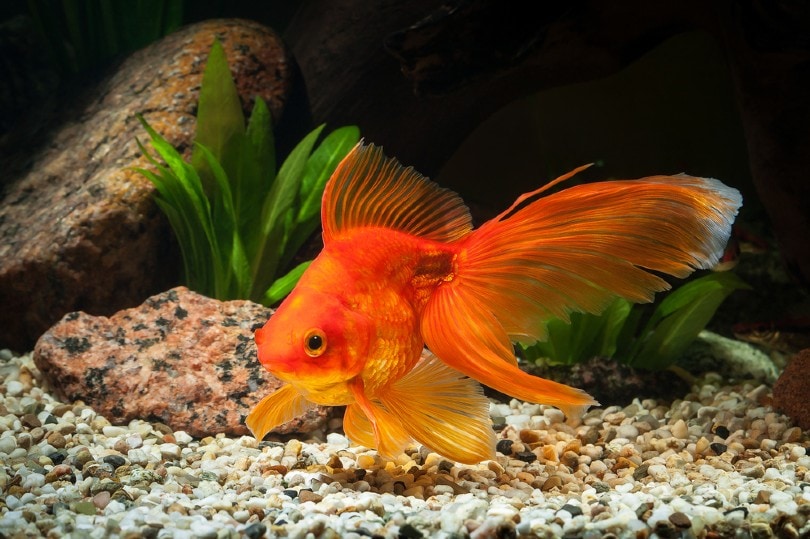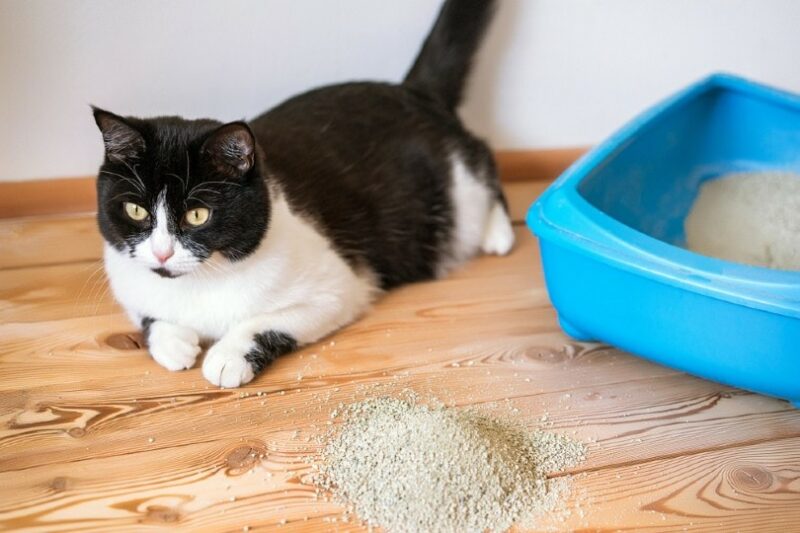Goldfish have the potential to live very long lives, sometimes in excess of 30 years! The key to keeping them alive for the longest amount of time is to provide them with the healthiest life possible by carefully managing everything from the water quality to their diet. If you have a goldfish that lives for more than a couple of years, it will experience an illness at some point.
Some illnesses are more severe and deadly than others, so it’s vital to your goldfish’s well-being to learn which diseases it might experience, how to identify them, and how to treat them. Here are some of the most common and some less common goldfish diseases, with pictures, videos, and information on how to treat and prevent them.

The 20 Goldfish Diseases With Pictures & Videos
1. Ich
This parasitic infection is caused by a parasite called Ichthyophthirius multifiliis that attaches itself to the body of the fish, causing the appearance of salt grains scattered across the body and fins. These parasites cause itching and irritation to the fish and can eventually lead to secondary infections and death if left untreated. Ich parasites drop egg packets into the water, where they hatch, creating free-swimming parasites that search for a host.
There are multiple treatments for ich, including medications, heat therapy, salt therapy, and alternative treatment options. Ich is contagious, so catching and treating it early will prevent a full-blown outbreak in the tank or pond. Quarantining new fish and plants and ensuring you don’t introduce water from pet stores into your tank can help prevent ich. Maintaining good water quality will also help you ensure the parasites cannot take hold in your tank.
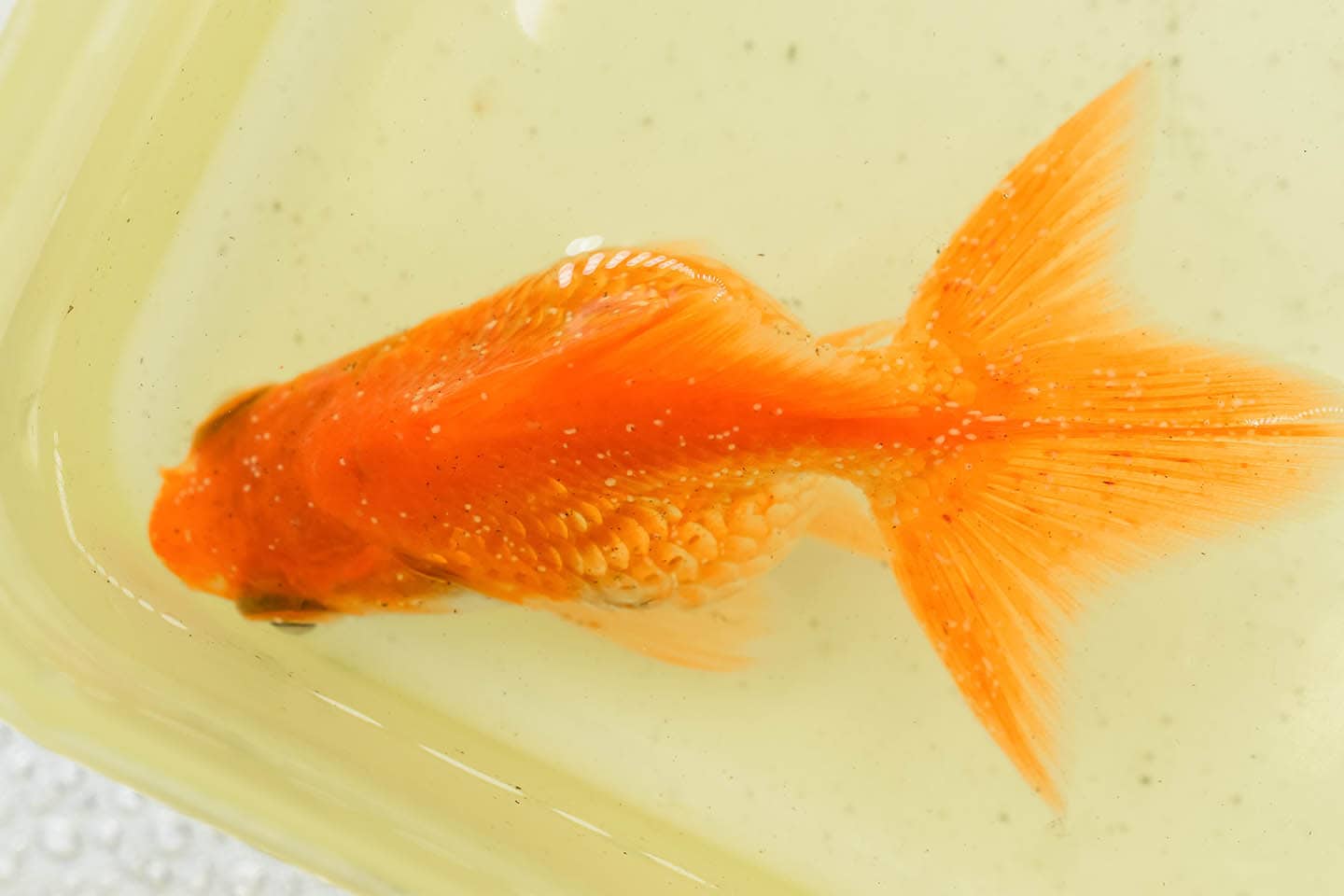
2. Velvet
Velvet is a parasitic infection that is uncommon in goldfish, but it shows up from time to time. Velvet, also called Gold Dust Disease or Rust, is easy to spot because it will leave your goldfish looking like it was sprinkled with gold or reddish-brown dust. Like ich, your fish will likely begin showing signs like flashing and clamped fins. These parasites attach themselves to the fish’s skin, creating a significant amount of irritation and itching. The fish begins overproducing its slime coat in response to the presence of the parasites.
Velvet is highly treatable with antiparasitic medications like copper. However, copper is deadly to invertebrates, like snails and shrimp, and can stay in the water for a long time since it is a heavy metal. Velvet is more deadly than ich, so make sure you quarantine new plants and fish for 1–2 weeks before adding to the main tank.

3. Fungus
Sometimes called Cotton Wool disease, fungal infections create fluffy, white patches on the fish. They can be concentrated around the mouth but may also be seen on various parts of the body and fins. You may see flashing or rubbing against structures in the tank.
Fungal infections can be treated with tea tree oil and bay tree oil-based water treatments. Some Ich treatments, like Ich-X, can be effective against fungal infections. The best prevention of fungal infections is keeping the water quality high and not keeping the water temperature too high. Warm temperatures often stimulate the growth of fungi.
4. Anchor Worms
Anchor worms are creepy parasites that attach themselves to the skin of goldfish and feed off it. They cause irritation and bleeding around the bite location and allow bacterial infections to enter the skin and bloodstream. The worms are visible to the naked eye and can be seen sticking out from between the fish’s scales. They’re highly contagious and dangerous to your fish.
If you spot anchor worms on your goldfish, you should manually remove them carefully with a pair of tweezers and then gently clean the area with a cotton swab soaked in hydrogen peroxide if you are able. Potassium permanganate is an effective treatment against anchor worms and can be used as a tank treatment or a bath. Other treatments, like Microbe-Lift, treat the fish and the tank effectively.

5. Flukes
These microscopic parasites can infect the skin and gills of goldfish. They attach to the fish, feeding off its blood, eventually leading to secondary infections and death. Goldfish with flukes may be seen flashing or clamping their fins. If gill flukes are present, you may see redness around the gills and rapid or difficulty breathing.
Flukes are treatable with antiparasitic medications, but they are contagious and should be treated as soon as you suspect them. They are common, especially in fish from large breeding operations, like pet store goldfish, so make sure you quarantine and prophylactically treat any fish you bring home before adding it to your tank.
If your fish isn't behaving or looking as it normally does and you suspect it may be sick, ensure you provide the right treatment, by checking out the best-selling and comprehensive book The Truth About Goldfish on Amazon today.
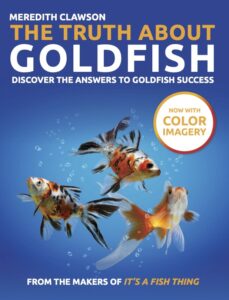
It has entire chapters dedicated to in-depth diagnoses, treatment options, a treatment index, and a list of everything in our fishkeeping medicine cabinet, natural and commercial (and more!).
6. Fish Lice
These parasites are visible to the naked eye as disc-shaped, green flecks that visibly move around on the fish. Severe cases cause red or bloody areas on the fish’s skin, but you’re likelier to see signs like flashing and clamped fins. Fish lice are more common in ponds than aquariums, so you’re unlikely to spot them in your aquarium unless you’ve brought a fish in from an established pond.
Fish lice can be difficult to treat but are usually susceptible to the same treatments as anchor worms, so potassium permanganate and Microbe-Lift are great options. They are usually resistant to salt treatments. To prevent fish lice, quarantine the new fish before adding them to the new tank. This is especially important when bringing in fish from outdoor environments.

7. Chilodonella
This is a microscopic parasite that attaches itself to goldfish, causing irritation and stress. Chilodonella can stay dormant for extended periods, only taking hold when a stressed goldfish has a depressed immune system. The signs include clamped fins, lethargy, red areas on the skin, excess slime coat production, and air gulping, which occurs in the end stages of this infection.
The best treatment is aquarium salt baths or water treatments. Formalin and potassium permanganate can also be used instead of salt. The best prevention for this is quarantining new plants and animals before adding them to your tank. New animals are often stressed and may begin to show signs of illness while in quarantine.
8. Trichondia
While trichondia parasites aren’t dangerous for your goldfish, they are incredibly irritating to the skin and can lead to flashing and rubbing against the substrate or décor in the tank. Trichondia parasites don’t feed on goldfish; rather, they attach to the goldfish, using them as a place to live while the parasites consume bacteria. Your goldfish may develop red, raw spots from rubbing against items.
Trichondia is treatable with salt baths, salt treatments for the tank, potassium permanganate, and anti-parasitic medications. They can enter your tank via infected fish, plants, or water. Ensure you properly quarantine anything you’re adding to your tank.
9. Ulcers
Ulcers are open wounds on the surface of the skin. They are typically caused by bacteria that take advantage of decreased immunity. The earliest signs of ulcers are redness that continues to worsen over time. The scales may fall off in the area of the ulcer. Ulcers open up a pathway for internal infections to occur, so treat them as early as possible.
Most ulcers can be treated by improving the water quality to keep the wound clean while it heals. You can treat it with antibacterial medications as well, which will help keep the wound clean and clear of bacteria. If your fish will let you, you can clean the wound with a cotton swab dipped in hydrogen peroxide. Don’t do this daily since hydrogen peroxide can kill healthy cells trying to heal. Salt baths or salt treatments in the tank may help with healing as well.

10. Black Spot
This is not a disease, but it indicates elevated ammonia levels in the water. Usually, black spots will appear while the fish is healing as ammonia levels decrease, but long-term exposure to elevated ammonia levels can lead to black spots while the ammonia is still elevated as the fish’s body attempts to heal itself.
Some goldfish change colors with age, so if you notice black spots developing, there isn’t necessarily a problem, but it’s a good idea to check your water parameters to verify your ammonia levels aren’t elevated.
11. Bacterial Gill Disease
Bacterial gill disease affects the gills, gill covers, and the area around them. Fish with bacterial gill disease have redness and swelling in and around the gills that worsen with time. As time passes, the gills will fuse to the body, eventually closing them completely. Even with treatment, the gills will not separate independently and require human intervention. Fish with this disease have rapid breathing, difficulty breathing, lethargy, and a lack of appetite.
This disease is uncommon in goldfish and usually occurs in large-scale breeding operations of food fish, like salmon, but it can occur in goldfish kept in overstocked environments with poor water quality. Ensure your water quality is high and treat it with antibiotic medications like kanamycin, neomycin, and tetracycline or antibacterial medications like nitrofurazone.
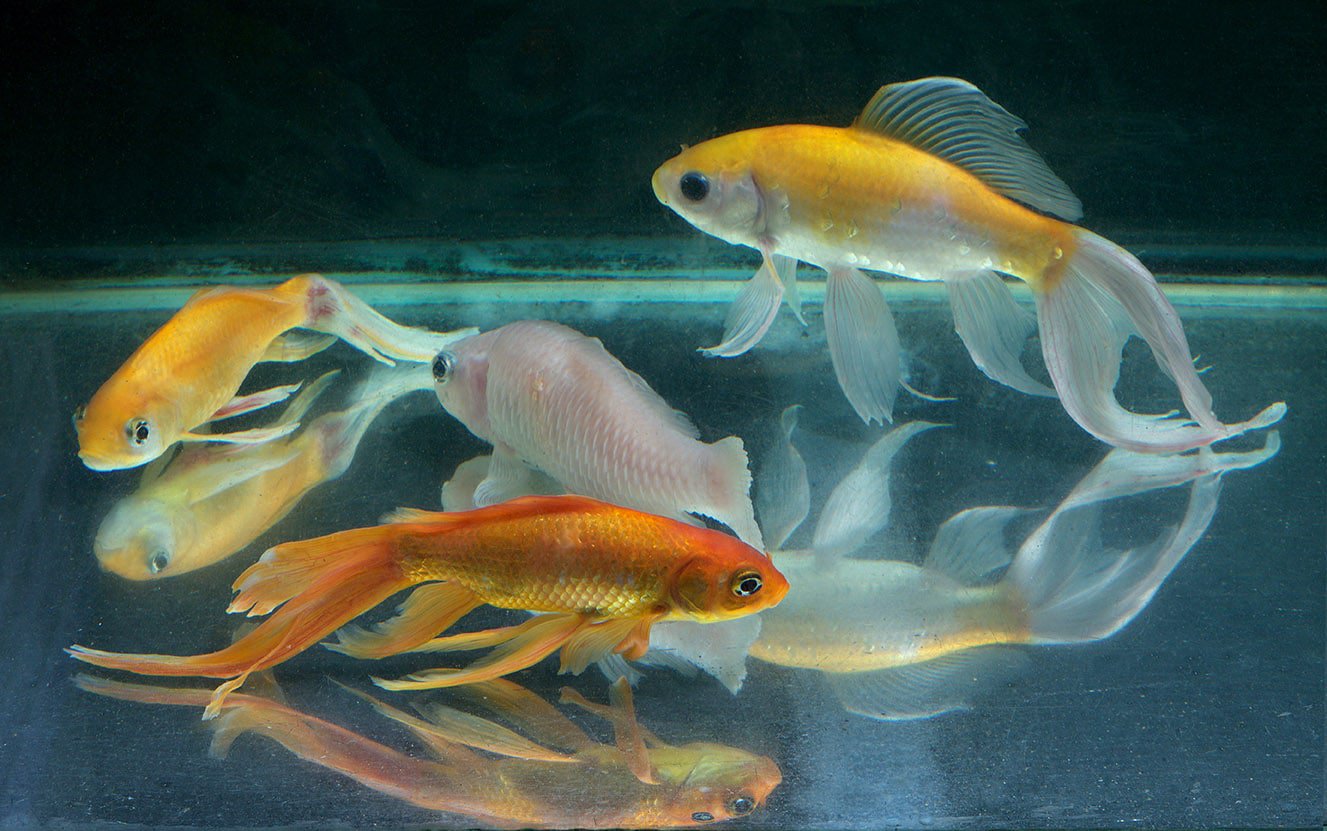
12. Mouth Rot
Mouth rot can be caused by parasites or bacteria and is a deadly infection if allowed to enter later stages. Catch it early by watching your fish rub its mouth on items in the tank or redness in and around the mouth. Mouth rot will cause the external structures of the mouth, including the lips, to rot away, leaving nothing but a large, open hole behind. Fish that have reached this point often cannot eat or have great difficulty and may require hand feeding.
Prevent mouth rot by maintaining water quality and monitoring your fish closely for signs. In the early stages, you can treat mouth rot at home with antibiotics like kanamycin and antibacterials like nitrofurazone. As this disease advances, it may require veterinary intervention and antibiotic injections to save the fish’s life.
13. Fin Rot
This bacterial infection causes the fins to slowly tear and dissolve until the fin is down to the nub. You may notice a cloudiness in the fins, a jagged or shredded appearance, or pieces of the fins slowly peeling or rotting off. Once the fins have rotted down, it’s unlikely they will grow back.
Products containing tea tree oil, like Melafix, can be effective against fin rot. Antibiotics, like kanamycin or sulfamethoxazole, are very effective but can be hard on your fish. Adding Stress Coat or another product to protect and stimulate the slime coat can help reduce stress and prevent further damage. To prevent fin rot, ensure your water quality is high and your parameters are where they should be.
14. Hole in the Head Disease
Hole in the head disease is caused by a parasite and is not as common in goldfish as it is in other fish, like cichlids, but it does still occur. Hexamita parasites are usually opportunistic and cause infections when your goldfish’s immune system is depressed because of stress or other illnesses. This disease often goes hand in hand with a secondary bacterial infection. Hexamita causes a pitting ulcer, usually on the face and head, that creates a deep hole. Eventually, this leads to a systemic bacterial infection and can cause death.
The first step in treatment is to check your parameters and do whatever is necessary to improve the water quality. Goldfish cannot heal from this infection in a tank with poor water quality. If you can, gently clean the wound with a cotton swab dipped in hydrogen peroxide. Do not do this more than once because hydrogen peroxide can kill healthy tissue. You must treat your fish with antibiotics, like metronidazole, and antiparasitic medications.

15. Pop Eye
Some fish, like telescope and bubble-eye varieties of goldfish, are prone to losing an eye, but pop eye is a bacterial infection that can cause this. Pop eye is a dangerous systemic infection recognizable by swelling or fluid pouches around the eyes or even the eyes themselves bulging out. This increases the risk of losing an eye significantly.
Pop eye can be treated with salt treatments and a powerful antibiotic like kanamycin. It’s essential to try to catch this early to prevent your fish from losing one or both of its eyes. Pop eye isn’t completely preventable, but keeping your water parameters in check and your water quality high can significantly decrease the risk of its occurrence.
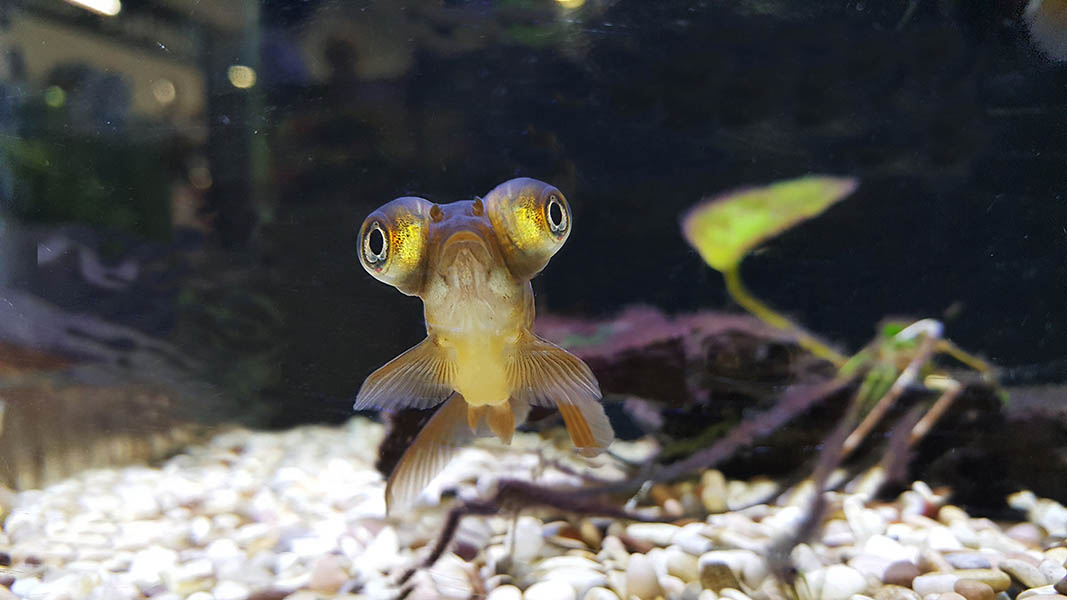
16. Cloudy Eye
This isn’t a specific disease, but it’s an indicator that an injury has occurred on the eye’s surface that has led to an infection. Telescope and bubble-eye goldfish are at an increased risk. You will see a hazy or cloudy look in one or both eyes. Cloudy eye can be caused by ammonia burns or injuries that allow bacteria to enter the eye.
Treatment of cloudy eye involves improving the water quality to help the eyes heal. Salt baths or tank treatments can help treat this condition. Antibiotics or antibacterials may be useful, but they do not always make a difference. Keep your tank free of sharp or jagged edges if you keep fish with protruding eyes.
17. Carp Pox
This disease appears like warts on your goldfish’s scales or fins. Thankfully, it looks much worse than it is. Carp pox does not injure the fish and typically does not cause pain or irritation. It is caused by a herpes virus, and once your goldfish has carp pox, they will always have it. It may appear to heal but will usually reoccur later. There is no good prevention for carp pox except to purchase your goldfish from environments where they have not had these symptoms occur before.

18. Tumors and Growths
Just like other animals, goldfish can develop tumors and growths. They are not always cancerous or malignant, but they can become uncomfortable. If you notice an unusual lump on your goldfish, you can monitor it closely for changes. If it continues to grow or begins to interfere with normal activities, like swimming or eating, euthanasia is usually the kindest choice.
Some veterinarians are equipped to remove tumors from goldfish, which is an option you can explore. There is no known prevention for tumors except maintaining water quality to decrease the chance of their occurrence.
19. Lymphocystis
Lymphocystis is similar to carp pox in that it is not dangerous, and it usually reoccurs. It’s characterized by cauliflower-shaped growths on the fish, which are usually pink. This disease has no treatment and is self-limiting, which means it will clear up on its own.
Preventing lymphocystis is accomplished by keeping your goldfish in a stress-free environment. Stressed fish with decreased immunity are at risk for developing lymphocystis, which may or may not reoccur if your fish is kept in a low-stress environment.

20. Dropsy
Dropsy isn’t a disease on its own, but it is a sign of a serious problem inside the goldfish. Dropsy is a collection of fluid within the fish’s abdomen, causing noticeable swelling. When this swelling occurs, the fish will often “pinecone,” which means the scales begin to stick out from the body, similar to the way a pinecone looks.
Dropsy isn’t entirely preventable because it can be associated with multiple medical problems. Poor water quality, sepsis, organ failure, and even a diet that isn’t nutritionally sound can all lead to dropsy occurring. Once dropsy signs develop, the fish is already seriously ill. You can attempt to treat dropsy with strong antibiotics, like kanamycin, salt baths, and improvements in water quality. Dropsy is usually fatal, and sometimes, euthanasia is the kinder choice for seriously ill fish.

How Can I Determine if My Goldfish is Even Sick?
If your goldfish appears to be experiencing any signs of an illness, either in appearance or behavior, your first course of action is simple: check your water parameters. Preferably, they should be checked correctly and quickly using a trustworthy test kit. Follow the directions for each specific test within the kit because some require different numbers of drops, lengths of time shaking, and lengths of time until the test result is read.
As a quick reminder, here’s what your water parameters should look like:
- pH: 6.5-7.5
- Ammonia: 0
- Nitrite: 0
- Nitrate: up to 20-40
Also, make sure your water temperature stays in the 64°-74°F range, give or take. Water that is too cold may cause your goldfish to enter torpor, a semi-hibernation state that causes the metabolism to drop significantly. Your goldfish will become less active and eat less. Water that is too warm may lead to stress, which can lead to a depressed immune system. Warm water also has less dissolved oxygen, making it more difficult for your goldfish to breathe properly.
Problems with the water quality in the goldfish’s environment are the most common cause of illnesses and abnormal behaviors. Increased ammonia and nitrite can lead to poisoning, which can cause fin damage, color changes, and lethargy. Problems with the water parameters can also increase stress and cause physical changes like a decrease in the slime coat, which can increase the risk of developing infections. Poor-quality water can also quickly become a breeding ground for parasites and bacteria.
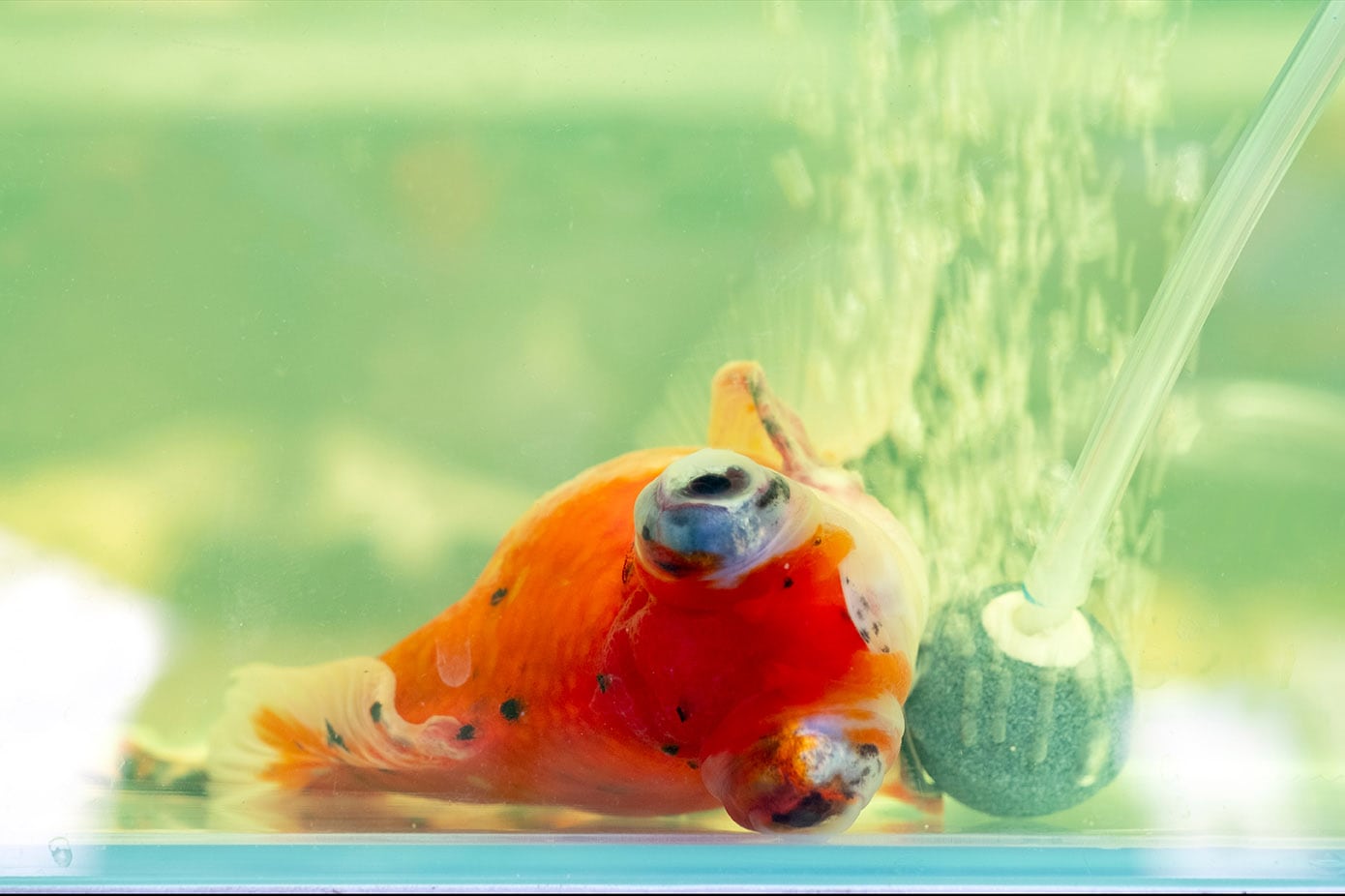

Conclusion
This isn’t a comprehensive list of diseases and infections your goldfish can get, but these are the most likely to occur. Keeping your water quality high is your best defense against these diseases. Quarantining new plants and animals can keep your tank safe and allow you to catch diseases your new fish may have early. Early identification and quick treatment of these diseases are vital to helping your goldfish heal and return to good health. Keeping a low-stress tank and feeding a balanced diet are also crucial.
You May Also Like:
- 9 Weird Facts About the 12 Oldest Goldfish in the World
- The Best Healthy Goldfish Diet: Feeding & Nutrition Guide
- Goldfish Swim Bladder Disease: Symptoms, Treatment & Prevention
Featured Image Credit: dien, Shutterstock
Contents
- The 20 Goldfish Diseases With Pictures & Videos
- 1. Ich
- 2. Velvet
- 3. Fungus
- 4. Anchor Worms
- 5. Flukes
- 6. Fish Lice
- 7. Chilodonella
- 8. Trichondia
- 9. Ulcers
- 10. Black Spot
- 11. Bacterial Gill Disease
- 12. Mouth Rot
- 13. Fin Rot
- 14. Hole in the Head Disease
- 15. Pop Eye
- 16. Cloudy Eye
- 17. Carp Pox
- 18. Tumors and Growths
- 19. Lymphocystis
- 20. Dropsy
- How Can I Determine if My Goldfish is Even Sick?
- Conclusion
